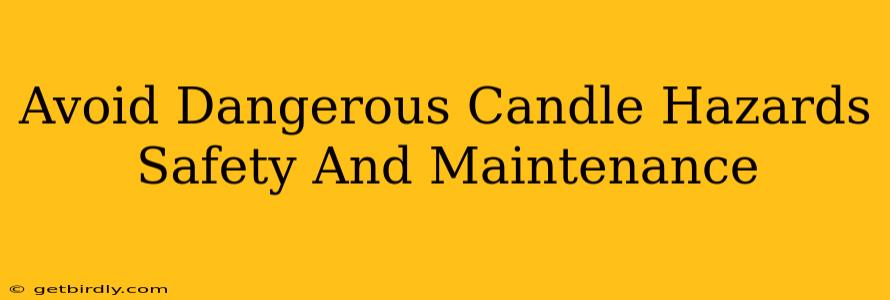Avoid Dangerous Candle Hazards: Safety & Maintenance
Candles create a warm, inviting ambiance, but their flickering flames also present potential dangers. Understanding and implementing proper safety and maintenance practices is crucial to enjoying the beauty of candles without risking injury or property damage. This comprehensive guide will equip you with the knowledge to minimize candle-related hazards and ensure a safe and enjoyable experience.
What are the Common Dangers of Candles?
Candles, while beautiful, pose several risks if not handled correctly. These include:
-
Fire Hazards: This is the most significant risk. Unattended candles are a leading cause of house fires. A carelessly placed candle can easily ignite nearby flammable materials like curtains, furniture, or papers.
-
Burns: Hot wax, glass containers, and even the flame itself can cause severe burns. Children and pets are particularly vulnerable.
-
Smoke Inhalation: Burning candles produce smoke, which can trigger respiratory issues, especially in individuals with asthma or other breathing conditions.
-
Toxic Fumes: Certain scented candles may release potentially harmful chemicals into the air. Choose candles made with natural, non-toxic ingredients whenever possible.
-
Falling and Breaking: Knocking over a lit candle can lead to a fire or serious injuries from broken glass.
How to Prevent Candle-Related Accidents: Safety Precautions
Proper Placement is Key:
-
Never leave a burning candle unattended. This is the most important safety tip. Always extinguish candles before leaving a room or going to sleep.
-
Keep candles away from flammable materials. Maintain a safe distance from curtains, furniture, bedding, papers, and other combustibles.
-
Place candles on a stable, heat-resistant surface. Avoid using wobbly surfaces or those that could easily be knocked over. Use a sturdy candle holder or plate.
-
Keep candles out of reach of children and pets. Store candles in a high, secure location inaccessible to curious hands and paws.
-
Avoid placing candles in drafts. A gust of wind could easily extinguish a candle or cause it to tip over.
Choosing the Right Candles:
-
Opt for candles with a stable base. Avoid candles with a narrow or unstable base.
-
Consider the size and type of candle. Large candles may require more attention and supervision than smaller ones.
-
Read the candle's label carefully. Pay attention to burning instructions and warnings.
-
Choose candles with natural wicks. Natural wicks tend to burn more cleanly and produce less smoke.
Safe Candle Burning Practices:
-
Trim wicks before each use. A long wick can produce excessive smoke and soot and can also lead to a larger, more unstable flame. Trim the wick to about ¼ inch.
-
Don't burn candles for extended periods. Follow the manufacturer's instructions regarding burn time. Allow the wax to melt evenly across the entire surface to prevent tunneling.
-
Never move a burning candle. The hot wax could spill and cause burns or a fire.
-
Extinguish candles properly. Use a candle snuffer to avoid splattering hot wax or releasing smoke. Never blow out candles.
Candle Maintenance: Extending the Life and Safety of Your Candles
Proper Storage:
-
Store candles in a cool, dry place. Extreme temperatures or humidity can affect the quality of the wax.
-
Keep candles away from direct sunlight. Sunlight can fade the color and scent of the candle.
-
Protect candles from dust and debris. Store candles in sealed containers or boxes to prevent damage.
What to Do if a Candle Fire Starts: Emergency Procedures
-
Remain calm. Panic can hinder your ability to act effectively.
-
If the fire is small and contained, carefully cover the flame with a heavy, non-flammable object such as a metal lid or baking sheet. This will smother the fire and deprive it of oxygen.
-
If the fire is larger or spreading, evacuate the premises immediately and call the fire department. Never attempt to put out a large fire yourself.
Frequently Asked Questions (FAQ)
How often should I trim my candle wicks?
Trim your candle wicks before each use to about ¼ inch. This helps prevent excessive smoke, soot, and an unstable flame.
What causes candles to tunnel?
Candle tunneling happens when the wax melts only in the center, leaving a large well around the wick. This is usually caused by burning the candle for too short a period, resulting in incomplete melting of the wax.
Are all scented candles safe?
No. Some scented candles contain synthetic fragrances and chemicals that could release harmful fumes when burned. Look for candles made with natural essential oils and non-toxic materials.
Can I reuse candle jars?
Once the candle wax is completely removed and the jar is thoroughly cleaned, many candle jars can be reused for storage or other decorative purposes.
By following these safety tips and maintenance practices, you can enjoy the beauty and ambiance of candles while minimizing the risks. Remember, prevention is key to ensuring a safe and enjoyable candle-lit experience.

